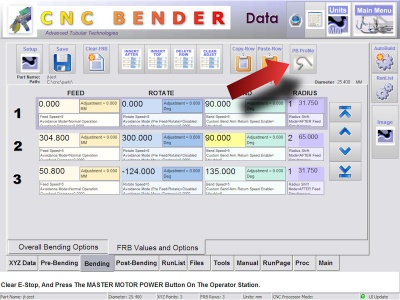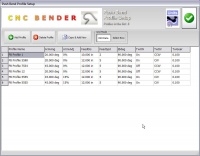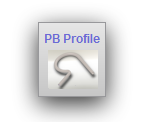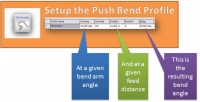Difference between revisions of "Push Bending Profile Table"
(→Profile Values) |
(→Profile Values) |
||
| Line 69: | Line 69: | ||
|} | |} | ||
|} | |} | ||
| − | |||
<br><br> | <br><br> | ||
| + | |||
| + | |||
| + | ==How it Works== | ||
| + | See this diagram as an illustration of how our push-bending works: | ||
| + | |||
| + | [[image:push_bend_profile_diagram_three_foundational_values.jpg|200px]] | ||
== Other Pages == | == Other Pages == | ||
See [[CNC Bender v11-20080424]] for information on the first version to enable Push Bending | See [[CNC Bender v11-20080424]] for information on the first version to enable Push Bending | ||
Revision as of 14:59, 20 October 2008
Contents |
About Push Bending Profile Tables
This is a sample Push Bend Profile Table. Each profile row contains a profile setup for a given radius. An unlimited number of profile values can be entered. Using this method of calculation, it is possible to calculate different Push Bends by indicating the new bend angles.
Because we use this method of calculation, it is possible to correct push bent parts using measuring center connections. Correct the bend value, and the push bend values are automatically calculated during AutoBuild.
Loading the Profile Table Menu
The Profile Table Setup is entered from the FRB screen only. The button is to the right in the button toolbar at the top.
The button is labeled "PB Profile" which stands for "Push Bending Profile."

Profile Values
| Value Name | Description | ||
|---|---|---|---|
| Profile Name | The "Profile Name" is what you use to identify a profile in the rest of CNC Bender. | ||
| Arm Angle | This is the final angle of the arm during Push Bending. | ||
| Arm vAdjust | This allows the velocity of the bend arm to be adjusted by a percentage of the original calculated velocity. | ||
| Feed Position | This is how far the carriage must travel to achieve the "@ Degrees" value programmed at the far right side of the table. For example, to achieve a bend angle of 90 degrees may require the carriage to move forward 10 inches. These two values combined allow CNC Bender to calculate other bend angle values (which translate to carriage motion) for this Profile. | ||
| Feed Velocity | This is the velocity of the carriage during the bend for this profile. The velocity of the carriage is also used to calculate a starting bend arm motion speed. The two are directly proportional. For example, an increase in Feed velocity will cause an increase in Bend Arm velocity so that the two can stay synchronized. If the calculated Bend Arm velocity is ever greater than the bender's maximum bend arm speed, then CNC Bender will cap the value at the maximum. If this happens, then a remark is placed in the Processlist just before the Push Bend. | ||
| @ Degrees | This is the angle of the tube that is achieved by the "Feed Position" value above. | ||
| Twist ON | This switches the rotational twist ON/OFF in the profile.
| ||
| Twist CCW | This controls the direction of the twist. The choices are CCW or CW from the front of the bender.
| ||
| Twist Velocity | This controls the velocity in degrees per second (not the standard 1-10 speed). The DPS value gives finer control of the rotational velocity. CNC Bender will not allow the Process List Builder to use any DPS speed that is greater than the DPS value for speed 10 (set in Low Level). The twisting action stops automatically when the feed motion is complete. It is dependent on the Feed axis in Push Bending.
| ||
| |||
How it Works
See this diagram as an illustration of how our push-bending works:
Other Pages
See CNC Bender v11-20080424 for information on the first version to enable Push Bending





